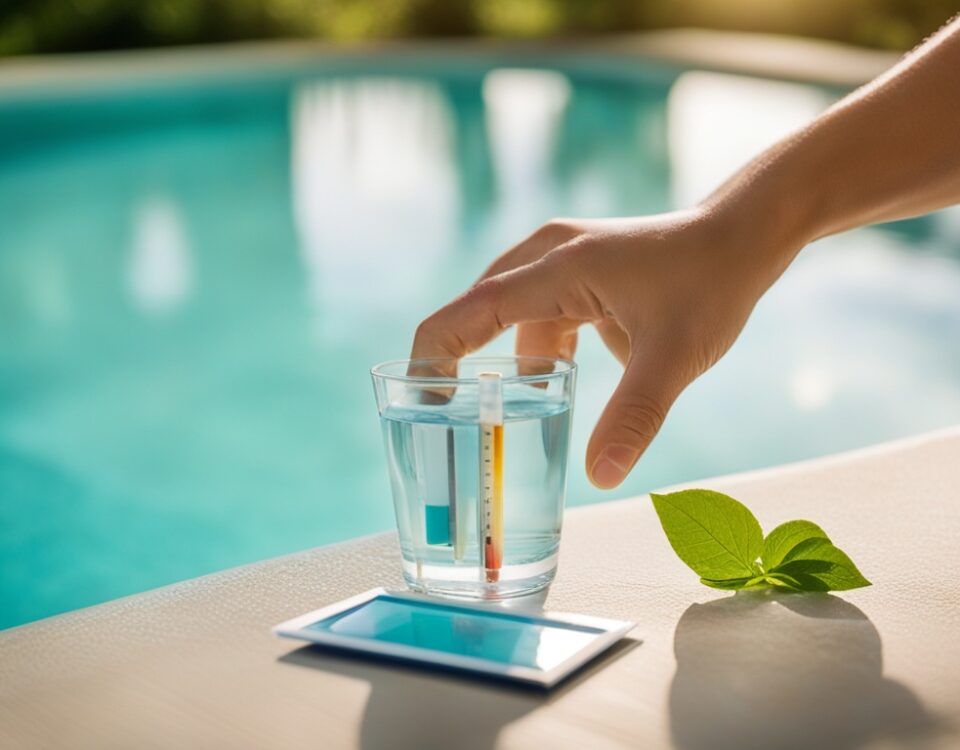Master Your Oasis: Essential Pool Maintenance Checklist

Sleek Serenity: 10 Minimalist Pool Design Ideas to Transform Your Space
May 9, 2025
Sparkling Secrets: Transform Your Pool with Expert Tile Cleaning Tips!
May 11, 2025Introduction to Pool Maintenance Checklist
The allure of a shimmering pool on a hot summer day is undeniable; however, ensuring that your aquatic oasis remains in pristine condition necessitates a dedicated approach to regular pool maintenance. Without consistent upkeep, even the most luxurious swimming pools can suffer from a myriad of issues, ranging from algae growth to equipment malfunctions. This is precisely why a well-crafted pool maintenance checklist is indispensable for pool owners.
A pool maintenance checklist serves as a practical guide, outlining critical tasks that need to be performed on a routine basis. By following this checklist, you can efficiently manage your pool’s cleanliness, safety, and functionality. Moreover, it provides peace of mind, allowing you to enjoy your swimming experience without the nagging worry of overlooking vital maintenance tasks.
Importance of Regular Pool Maintenance
Proper pool maintenance transcends simple aesthetic appeal; it significantly affects the overall health and safety of pool users. Neglecting maintenance can lead to the proliferation of harmful bacteria and pathogens, creating a hazardous environment for you and your loved ones. Furthermore, consistent care helps to extend the lifespan of essential equipment, such as filters and pumps, thus saving you substantial costs in the long run.
Benefits of Utilizing a Pool Maintenance Checklist
Employing a pool maintenance checklist has numerous advantages. First and foremost, it promotes consistency in your upkeep routine. By dividing responsibilities into manageable tasks, you can prevent the overwhelming feeling of tackling a neglected pool all at once. For instance, your checklist can clearly delineate daily, weekly, monthly, and seasonal tasks, enabling systematic approaches to maintenance.
Additionally, having a comprehensive checklist enhances accountability, particularly for shared responsibilities among family members. Each person can know their specific tasks, fostering a collaborative atmosphere and ensuring that nothing falls through the cracks. Beyond accountability, a structured checklist encourages proactive maintenance, which can identify potential issues before they develop into costly repairs.
What to Include in Your Pool Maintenance Checklist
Your pool maintenance checklist should encompass a variety of tasks to ensure thorough care. This includes checking and balancing water chemistry, removing debris, cleaning filters, and inspecting pool equipment. For optimal effectiveness, it might be beneficial to organize these tasks into a table like the one below:
| Frequency | Maintenance Tasks |
|---|---|
| Daily | Test water chemistry, remove debris from the pool surface. |
| Weekly | Brush pool walls, vacuum floor, clean skimmer and pump baskets. |
| Monthly | Check water levels, inspect pool equipment, test for Total Dissolved Solids (TDS). |
| Seasonal | Winterize the pool, inspect liners, and perform deep cleaning. |
Weekly Pool Maintenance Tasks
Maintaining a pristine swimming pool is an art form that blends dedication with precision. The essence of effective pool maintenance lies in a well-structured weekly routine that guarantees sparkling water and a safe swimming environment. Below are the essential tasks you should perform weekly to keep your pool in optimal condition.
Cleaning and Skimming the Pool Surface
One of the most straightforward yet crucial tasks is cleaning and skimming the pool surface. Leaves, insects, and debris can accumulate rapidly, especially during seasonal changes. Utilizing a skimmer net, carefully remove visible obstructions floating on the water’s surface. Regular skimming enhances the pool’s aesthetic appeal and helps prevent debris from sinking and contributing to algae growth.
Checking and Maintaining Proper Water Levels
Next, ensure the water level is adequate for optimal performance of the pool skimmer and pump. A low water level can cause the pump to run dry, risking damage, whereas an excessively high level can impede skimming effectiveness. Ideally, the water should sit at the midpoint of the skimmer opening. Adjust the water level using a garden hose or a pool fill line as needed, taking into account evaporation and usage.
Testing and Balancing Pool Water Chemistry
Maintaining balanced pool water chemistry is paramount for a healthy swimming experience. Each week, utilize a reliable pool water test kit to check for key chemical levels, including pH, chlorine, alkalinity, and stabilizer. The *ideal pH range* is between 7.2 and 7.8, while chlorine should typically hover around 1-3 parts per million (ppm). Adjust these levels accordingly using appropriate chemicals, ensuring the pool remains safe and enjoyable for all swimmers.
Inspecting and Cleaning Pool Filters
Filters are the unsung heroes of pool maintenance, efficiently removing dirt and impurities. During your weekly checklist, inspect and clean the pool filters to maintain their effectiveness. Depending on the type of filter—cartridge, sand, or DE (diatomaceous earth)—cleaning methods will vary. For cartridge filters, rinse with a hose to remove debris, while sand filters may require backwashing. Regular maintenance not only prolongs filter life but also enhances overall water quality.
| Task | Frequency | Tools Needed |
|---|---|---|
| Skim Surface | Weekly | Skimmer Net |
| Check Water Level | Weekly | Garden Hose |
| Test Water Chemistry | Weekly | Test Kit |
| Clean Filters | Weekly | Hose, Backwash Equipment |
Integrating these weekly tasks into your pool maintenance routine is essential for preserving the longevity and beauty of your pool. By diligently adhering to this checklist, you not only ensure a pristine aquatic environment but also create a safe haven for family and friends to enjoy during the warm months.
Bi-Weekly Pool Maintenance Tasks
Proper maintenance of your swimming pool is crucial to ensure a clean, safe, and enjoyable environment. Among the various tasks in your pool maintenance checklist, bi-weekly responsibilities play a significant role in prolonging the life of your pool and enhancing its overall aesthetic appeal. Below, we delve into the essential bi-weekly maintenance tasks you should prioritize.
Brushing and Vacuuming the Pool
One of the cornerstones of an effective pool maintenance routine is brushing and vacuuming the pool’s interior surfaces. Brushing should be conducted at least once every two weeks to dislodge dirt and algae that may have settled on the walls and floor of the pool. Utilize a pool brush designed for your specific pool surface—whether it be plaster, vinyl, or fiberglass—to avoid damage.
Following the brushing, employ a vacuum to remove the dislodged debris. This step is integral not only for maintaining a sparkling clean pool but also for preventing the accumulation of dirt that can lead to murky water and unwanted bacteria growth. Depending on the type of vacuum used—whether manual, automatic, or robotic—adjust your technique accordingly to maximize efficiency. Consistent attention to this aspect of pool maintenance will keep water clarity high and potential issues at bay.
Backwashing the Pool Filter
Another pivotal bi-weekly task is the backwashing of the pool filter. A clean filter is essential for maintaining optimal water quality and flow rates. Over time, debris accumulates within the filter, reducing its efficiency and potentially causing damage. By backwashing, you reverse the flow of water through the filter, flushing out the trapped contaminants, which greatly enhances the filtration process.
It is advisable to check your filter pressure gauge regularly. If the gauge reads 8-10 psi above the normal operating level, it’s a clear indication that backwashing is necessary. Additionally, remember to rinse your filter after backwashing, which ensures that any residual dirt is eliminated—thus prolonging the life of your filter and improving pool hygiene.
Inspecting and Cleaning Pool Pump and Skimmer Baskets
As part of your bi-weekly maintenance routine, inspecting and cleaning the pool pump and skimmer baskets cannot be overlooked. The skimmer basket collects leaves, debris, and insects, preventing them from clogging the pump and filter systems. A perfect time to check this basket is right after the brushing and vacuuming tasks.
Remove the skimmer basket, empty its contents, and rinse it to ensure efficient functionality. Additionally, take the opportunity to inspect the pool pump and its basket for any signs of wear or blockage. Regularly cleaning these filters not only protects your pool system but also enhances water circulation, thereby supporting a more inviting swimming environment.
| Task | Frequency | Duration |
|---|---|---|
| Brushing Pool Walls and Floor | Bi-Weekly | 15-30 minutes |
| Vacuuming | Bi-Weekly | 30-45 minutes |
| Backwashing Filter | Bi-Weekly | 10-15 minutes |
| Cleaning Skimmer Basket | Bi-Weekly | 5-10 minutes |
Monthly Pool Maintenance Tasks
Maintaining a pristine swimming pool requires diligence and regular attention. *Monthly maintenance tasks* are crucial to ensuring the longevity of your pool and the health of its users. One fundamental aspect of this routine is checking pool equipment for wear and tear. Regular inspections can help identify components that may be failing or require replacement. This entails examining filters, pumps, and heaters for any signs of damage, leaks, or inefficiency. Addressing these issues promptly can prevent costly repairs and keep your pool operational throughout the season.
Checking Pool Equipment for Wear and Tear
While some pool maintenance tasks can be performed by most homeowners, assessing the intricate components of your pool equipment might require a more experienced eye. Pay special attention to the following parts:
- Filters: Ensure that the filter media is clean and not clogged, as this can strain the pump.
- Pumps: Look for unusual noises or vibrations, which might indicate a need for servicing.
- Heaters: Check for proper operation, ensuring the heater is effectively keeping the water temperature comfortable.
After completing the inspection, *making adjustments or repairs as necessary* can significantly enhance the efficiency and safety of your pool setup.
Monitoring and Adjusting Pool Water Levels
Another important monthly maintenance task involves monitoring and adjusting *pool water levels*. Fluctuating water levels can affect the performance of your pool’s skimmers and circulation system. Ideally, the water level should be maintained at the midpoint of the skimmer opening for optimal functionality.
To monitor your pool’s water levels effectively, consider utilizing a simple gauge, or establish a consistent schedule to visually inspect the levels. If you find the water level is too low, *add water* as needed. Conversely, if it is too high, you can *drain some water* or utilize the pool’s drainage system to bring it down to the appropriate height.
Shocking the Pool to Prevent Algae Growth
Finally, shocking your pool is an essential monthly chore that helps prevent algae growth and keep the water clear and hygienic. This process involves adding a high dose of chlorine to the water, effectively eliminating harmful bacteria and promoting a safe swimming environment. The most opportune time for shocking your pool is in the evening, allowing the chemicals to work overnight without the interference of sunshine.
When shocking your pool, it is important to follow the manufacturer’s instructions regarding dosage based on your specific pool size. *Below is a reference table* for your convenience:
| Pool Size (Gallons) | Chlorine Dosage (Pounds) |
|---|---|
| 10,000 | 1 |
| 20,000 | 2 |
| 30,000 | 3 |
| 40,000 | 4 |
In conclusion, dedicating time to these critical monthly maintenance tasks—checking equipment, adjusting water levels, and shocking the pool—will yield substantial rewards in terms of pool safety, cleanliness, and longevity. Remember, proactive care is the cornerstone of an inviting and enjoyable swimming environment.
Seasonal Pool Maintenance Tasks
Closing the Pool for Winter
Preparing your pool for the winter months is a crucial task that requires meticulous attention to detail. One of the first steps is to thoroughly *clean the pool*, removing debris, leaves, and any contaminants. After cleaning, it’s essential to balance the water chemistry; this includes adjusting the levels of pH, alkalinity, and calcium hardness. Properly balanced water prevents damage to the pool surfaces and plumbing during freezing temperatures.
Opening the Pool for Summer
As the warmth of summer approaches, the reopening of your pool is an exciting yet involved process. Start by removing the pool cover and giving it a good wash to prevent mildew and bacteria growth. Once the cover is clean, inspect it for any damages that might have occurred during winter storage. It’s imperative to repair any tears or holes to ensure longevity for next season. After that, you can fill the pool with water if necessary and shock the water to eliminate any lingering contaminants.
Inspecting the Pool Cover for Damages
The integrity of your pool cover is vital in extending its lifespan and maintaining pool cleanliness during off-seasons. Every opening and closing, you should engage in a thorough examination, checking for signs of wear and tear like rips or fading. Additionally, *make note of the tension* across the cover; a loose cover can allow debris to enter the pool, complicating maintenance efforts. Regular inspections ensure that your pool remains protected from potential winter damage or summer debris buildup.
Checking Pool Heaters
One often overlooked, yet equally important, aspect of seasonal pool maintenance is ensuring the functionality of your pool heater. Before the start of the swimming season, inspect the heater for any signs of corrosion, wear, or malfunction. Pay attention to the *filters and hoses* as well, as clogs can impede performance. It’s wise to consult a professional if you notice any irregularities as they can efficiently *troubleshoot and service* the unit, ensuring that it runs smoothly when you need it most.
Maintaining Solar Covers
Solar covers are a sustainable option for heat retention in your pool, but they require regular upkeep to function effectively. During seasonal transitions, inspect the solar cover for damage, such as punctures or fading, that can compromise its efficiency. Ensure that it fits snugly over the pool surface to trap heat during the colder months. Incorporating *storage space* for the cover away from direct sunlight can greatly extend its usability. Regular checks on the cover will help maximize its thermal efficiency, thereby reducing heating costs.
Comprehensive Seasonal Checklist
| Task | Winterization | Spring Opening |
|---|---|---|
| Clean & Remove Debris | ✔️ | ✔️ |
| Balance Water Chemistry | ✔️ | ✔️ |
| Inspect Pool Cover | ✔️ | ✔️ |
| Check Heater Functionality | ✔️ | |
| Maintain Solar Cover | ✔️ |
Troubleshooting Common Pool Problems
Cloudy Water and How to Remedy It
Cloudy water is a frequent issue that pool owners encounter, significantly diminishing the aesthetic appeal of the pool while potentially indicating underlying problems. The primary reasons for cloudy water include poor filtration, imbalanced chemicals, or the presence of contaminants. To remedy this, start by testing your water chemistry—focusing on pH, alkalinity, and chlorine levels. Ideal pH levels should range between 7.2 and 7.8.
Once you have assessed and adjusted your water chemistry, it’s crucial to clean the filter, as this can often be the source of insufficient filtration. Run your filter continuously until water clarity improves, and consider adding a flocculant or clarifier, which helps to consolidate small particles that contribute to cloudiness. Regular vacuuming and brushing can also minimize debris that might cloud your water.
Algae Growth Prevention and Treatment
The intrusion of algae into a swimming pool can transform an inviting oasis into a green, uninviting pond. Foremost, prevention is your best defense. Ensure your pool’s water chemistry is consistently monitored; maintaining a free chlorine level of at least 1-3 ppm is vital. Additionally, brushing the walls and floor of your pool weekly helps dislodge algae spores before they can establish themselves.
In the event of an algae outbreak, swift action is crucial. Begin by shocking the pool with chlorine to eliminate the algae. Depending on the severity, this might require multiple treatments. Following this, brush the affected areas to remove algae clumps along the surfaces, and run the filter continuously to clear away dead algae. If issues persist, consider employing an algaecide targeted specifically for the type of algae present, ensuring optimal results.
Dealing with Pool Leaks and Equipment Malfunctions
Pool leaks can prove to be an insidious problem, often exacerbating water loss and spiking maintenance costs. If you suspect a leak, start with a simple bucket test; fill a bucket with pool water and place it on the first step of the pool, ensuring the water level is marked. After 24 hours, compare the water levels in the pool and bucket; if the pool’s water level has dropped significantly more than that in the bucket, a leak is likely present.
Identifying the cause of the leak is paramount. Examine the structure of the pool, incorporating areas such as skimmers, returns, and light fixtures, for cracks or fissures. Additionally, inspect equipment such as pumps, filters, and heaters for potential malfunctions. Prompt repairs not only save water but also prevent further damage to your pool structure and equipment.
| Common Problems | Primary Causes | Solutions |
|---|---|---|
| Cloudy Water | Poor Filtration, Imbalanced Chemicals | Test and balance water, clean filters, use clarifiers |
| Algae Growth | Insufficient Chlorine, Poor Maintenance | Shock the pool, use algaecides, maintain cleaning schedule |
| Leaks | Structural Damage, Equipment Malfunctions | Inspect pool and equipment, repair leaks immediately |
Importance of Professional Pool Maintenance
When it comes to ensuring the longevity and pristine condition of your swimming pool, the role of professional pool maintenance cannot be understated. Hiring experienced technicians provides numerous benefits that go far beyond simple cleaning. Understanding the *importance of enlisting experts* for your pool maintenance can lead to cost savings, enhanced safety, and a more pleasurable swimming experience.
Benefits of Hiring a Professional Pool Maintenance Service
Professional pool maintenance services offer a wealth of experience and specialized skills. These experts are trained to recognize potential issues before they escalate, saving you from costly repairs. Additionally, they possess the right tools and knowledge needed to balance chemicals correctly, ensuring that the water remains crystal clear and safe for swimmers. By maintaining optimal water conditions, professionals help prevent *algae growth* and the development of harmful bacteria that could pose health risks.
When to Consider Outsourcing Pool Maintenance Tasks
While some pool owners find success managing maintenance themselves, certain circumstances may warrant *outsourcing these tasks*. If you lack the time or expertise to keep your pool in top condition, hiring professionals becomes a viable solution. Additionally, during peak swimming seasons when pools undergo heavy usage, professional maintenance ensures that the pool remains in pristine condition amidst increased wear and tear. Moreover, if you notice persistent issues, such as cloudy water or inconsistent chemical readings, it’s advisable to seek professional help.
Tips for Finding a Reliable Pool Maintenance Company
Finding a trustworthy pool maintenance company can be a daunting task, but several strategies can simplify your search. Start by seeking recommendations from friends and family or checking online reviews. Pay attention to customer feedback, particularly concerning the quality of service and reliability. When narrowing down your options, consider asking potential companies for a free inspection and estimate, which can provide insight into their *capabilities and professionalism*.
Additionally, ensure that the company you choose is licensed and insured. This protects you in case of any accidents during maintenance work. Always inquire about their routine procedures and the products they use, as this will help you gauge their adherence to safety standards and environmental regulations. Lastly, a good maintenance company should offer flexible scheduling options and transparent pricing to accommodate your specific needs.
| Criteria | Importance |
|---|---|
| Experience | Crucial for identifying issues and performing effective repairs |
| Licensing and Insurance | Protects you from liabilities during service |
| Customer Reviews | Provides insight into reliability and service quality |
| Transparent Pricing | Ensures you understand costs upfront, avoiding hidden fees |
| Flexible Scheduling | Accommodates your busy lifestyle and pool usage patterns |
Ultimately, professional pool maintenance not only extends the life of your pool but also enhances the overall enjoyment of your recreational space. By choosing to rely on experts, you invest in a cleaner, safer, and more inviting swimming environment for you and your loved ones.
Learn more about Swimming Pool

Javier Morales is passionate about pool design, maintenance, and outdoor living. With years of hands-on experience, he offers practical tips, creative ideas, and expert insights to help readers make the most of their pool spaces. At Piscina Planet, Javier shares everything from seasonal care guides to the latest trends in pool innovation.




